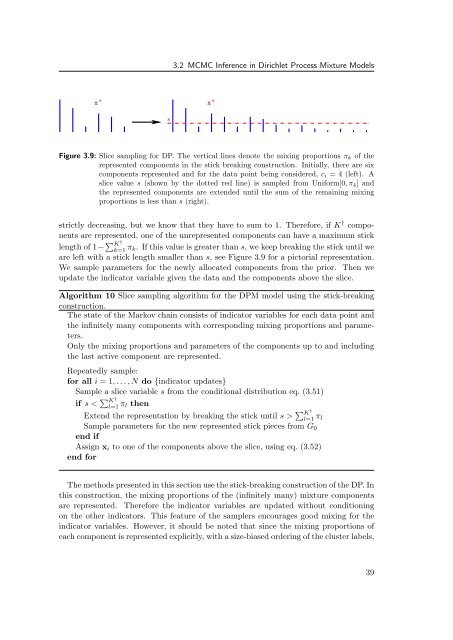Nonparametric Bayesian Discrete Latent Variable Models for ...
Nonparametric Bayesian Discrete Latent Variable Models for ...
Nonparametric Bayesian Discrete Latent Variable Models for ...
You also want an ePaper? Increase the reach of your titles
YUMPU automatically turns print PDFs into web optimized ePapers that Google loves.
∗<br />
π ∗ π<br />
s<br />
3.2 MCMC Inference in Dirichlet Process Mixture <strong>Models</strong><br />
Figure 3.9: Slice sampling <strong>for</strong> DP. The vertical lines denote the mixing proportions πk of the<br />
represented components in the stick breaking construction. Initially, there are six<br />
components represented and <strong>for</strong> the data point being considered, ci = 4 (left). A<br />
slice value s (shown by the dotted red line) is sampled from Uni<strong>for</strong>m[0, π4] and<br />
the represented components are extended until the sum of the remaining mixing<br />
proportions is less than s (right).<br />
strictly decreasing, but we know that they have to sum to 1. There<strong>for</strong>e, if K † components<br />
are represented, one of the unrepresented components can have a maximum stick<br />
length of 1− K †<br />
k=1 πk. If this value is greater than s, we keep breaking the stick until we<br />
are left with a stick length smaller than s, see Figure 3.9 <strong>for</strong> a pictorial representation.<br />
We sample parameters <strong>for</strong> the newly allocated components from the prior. Then we<br />
update the indicator variable given the data and the components above the slice.<br />
Algorithm 10 Slice sampling algorithm <strong>for</strong> the DPM model using the stick-breaking<br />
construction.<br />
The state of the Markov chain consists of indicator variables <strong>for</strong> each data point and<br />
the infinitely many components with corresponding mixing proportions and parameters.<br />
Only the mixing proportions and parameters of the components up to and including<br />
the last active component are represented.<br />
Repeatedly sample:<br />
<strong>for</strong> all i = 1, . . . , N do {indicator updates}<br />
Sample a slice variable s from the conditional distribution eq. (3.51)<br />
if s < K †<br />
l=1 πl then<br />
Extend the representation by breaking the stick until s > K †<br />
l=1 πl<br />
Sample parameters <strong>for</strong> the new represented stick pieces from G0<br />
end if<br />
Assign xi to one of the components above the slice, using eq. (3.52)<br />
end <strong>for</strong><br />
The methods presented in this section use the stick-breaking construction of the DP. In<br />
this construction, the mixing proportions of the (infinitely many) mixture components<br />
are represented. There<strong>for</strong>e the indicator variables are updated without conditioning<br />
on the other indicators. This feature of the samplers encourages good mixing <strong>for</strong> the<br />
indicator variables. However, it should be noted that since the mixing proportions of<br />
each component is represented explicitly, with a size-biased ordering of the cluster labels,<br />
39
















